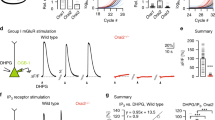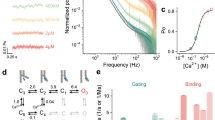Abstract
IN many cell types, receptor-mediated Ca2+ release from internal stores is followed by Ca2+ influx across the plasma membrane1–3. The sustained entry of Ca2+ is thought to result partly from the depletion of intracellular Ca2+ pools4,5. Most investigations have characterized Ca2+ influx indirectly by measuring Ca2+-activated currents6–9 or using Fura-2 quenching by Mn2, which in some cells enters the cells by the same influx pathway10,11. But only a few studies have investigated this Ca2+ entry pathway more directly12–14. We have combined patch-clamp and Fura-2 measurements to monitor membrane currents in mast cells under conditions where intracellular Ca2+ stores were emptied by either inositol 1,4,5-trisphosphate, ionomycin, or excess of the Ca2+ chelator EGTA. The depletion of Ca2+ pools by these independent mechanisms commonly induced activation of a sustained calcium inward current that was highly selective for Ca2+ ions over Ba2+, Sr2+ and Mn2+. This Ca2+ current, which we termICRAC (calcium release-activated calcium), is not voltage-activated and shows a characteristic inward rectification. It may be the mechanism by which electrically nonexcitable cells maintain raised intracellular Ca2+ concentrations and replenish their empty Ca2+ stores after receptor stimulation.
This is a preview of subscription content, access via your institution
Access options
Subscribe to this journal
Receive 51 print issues and online access
$199.00 per year
only $3.90 per issue
Buy this article
- Purchase on Springer Link
- Instant access to full article PDF
Prices may be subject to local taxes which are calculated during checkout
Similar content being viewed by others
References
Berridge, M. J. & Irvine, R. F. Nature 341, 197–205 (1989).
Irvine, R. F. FEBS Lett. 263, 5–9 (1990).
Meldolesi, J., Clementi, E., Fasolato, C., Zacchetti, D. & Pozzan, T. Trends pharmacol. Sci. 12, 289–292 (1991).
Casteels, R. & Droogmans, G. J. Physiol., Lond. 317, 263–279 (1981).
Putney, J. W. Jr Cell. Calcium 11, 611–624 (1990).
Bird, G. St J. et al. Nature 352, 162–165 (1991).
Morris, A. P., Gallacher, D. V., Irvine, R. F. & Petersen, O. H. Nature 330, 653–655 (1987).
Liano, I., Marty, A. & Tanguy, J. Pflügers Arch. 409, 499–506 (1987).
Snyder, P. M., Krause, K.-H. & Welsh, M. J. J. biol. Chem. 263, 11048–11051 (1988).
Sage, S. O., Merritt, J. E., Hallam, T. J. & Rink, T. J. Biochem. J. 258, 923–926 (1989).
Jacob, R. J. Physiol., Lond. 421, 55–77 (1990).
Penner, R., Matthews, G. & Neher, E. Nature 334, 499–504 (1988).
Matthews, G., Neher, E. & Penner, R. J. Physiol., Lond. 418, 105–130 (1989).
Lewis, R. S. & Cahalan, M. D. Cell Regulation 1, 99–112 (1989).
Marty, A. & Tan, Y. P. J. Physiol., Lond. 419, 665–687 (1989).
Matthews, G., Neher, E. & Penner, R. J. Physiol., Lond. 418, 131–144 (1989).
Eckert, R. & Chad, J. E. Prog. Biophys. molec. Biol. 44, 215–267 (1984).
Cullen, P. J., Comerford, J. G. & Dawson, A. P. FEBS Lett. 228, 57–59 (1988).
Thastrup, O., Cullen, P. J., Drobak, B. K., Hanley, M. R. & Dawson, A. P. Proc. natn. Acad. Sci. USA 87, 2466–2470 (1990).
Albert, P. R. & Tashjian, A. H. Jr J. biol. Chem. 259, 15350–15363 (1984).
Liu, C. & Hermann, T. E. J. biol. Chem. 253, 5892–5894 (1978).
Merritt, J. E., Jacob, R. & Hallam, T. J. J. biol. Chem. 253, 1522–1527 (1989).
Mertz, L. M., Baum, B. J. & Ambudkar, I. S. J. biol. Chem. 265, 15010–15014 (1990).
Kass, G. E. N., Llopis, J., Chow, S. C., Duddy, S. K. & Orrenius, S. J. biol. Chem. 265, 17486–17492 (1990).
Llopis, J., Chow, S. B., Kass, G. E. N., Gahm, A. & Orrenius, S. Biochem. J. 277, 553–556 (1991).
von zur Mühlen, F., Eckstein, F. & Penner, R. Proc. natn. Acad. Sci. U.S.A. 88, 926–930 (1991).
Neher, E. in Neuromuscular Junction (eds Sellin, L. C., Libelius, R. & Thesleff, S.) 65–76 (Elsevier, Amsterdam, 1989).
Author information
Authors and Affiliations
Rights and permissions
About this article
Cite this article
Hoth, M., Penner, R. Depletion of intracellular calcium stores activates a calcium current in mast cells. Nature 355, 353–356 (1992). https://doi.org/10.1038/355353a0
Received:
Accepted:
Issue Date:
DOI: https://doi.org/10.1038/355353a0
This article is cited by
-
Neuronal Store-Operated Calcium Channels
Molecular Neurobiology (2023)
-
STIM1-Orai1 interaction mediated calcium influx activation contributes to cardiac contractility of insulin-resistant rats
BMC Cardiovascular Disorders (2022)
-
New Insights on the Role of TRP Channels in Calcium Signalling and Immunomodulation: Review of Pathways and Implications for Clinical Practice
Clinical Reviews in Allergy & Immunology (2021)
-
Calcium entry units (CEUs): perspectives in skeletal muscle function and disease
Journal of Muscle Research and Cell Motility (2021)
-
Store-operated Ca2+ entry in primary murine lung fibroblasts is independent of classical transient receptor potential (TRPC) channels and contributes to cell migration
Scientific Reports (2020)
Comments
By submitting a comment you agree to abide by our Terms and Community Guidelines. If you find something abusive or that does not comply with our terms or guidelines please flag it as inappropriate.



